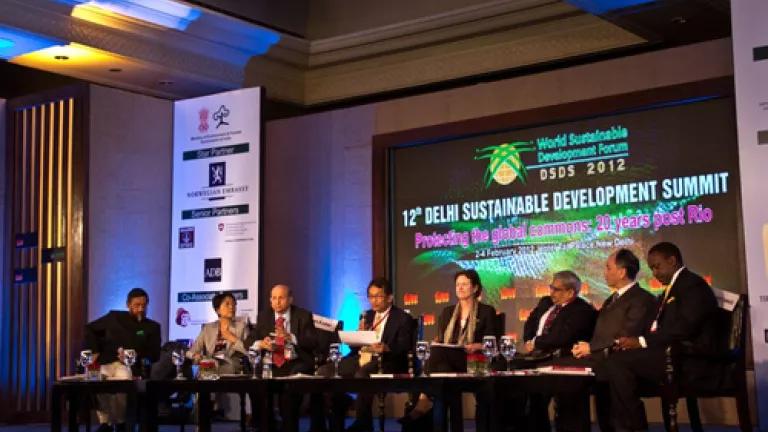
As I traveled through Mumbai and Delhi over the past few days, I’ve been awed by the rapid growth taking place in Indian cities. Statistics about urbanization abound, but experiencing the dynamic, jammed-packed streets firsthand is much more revealing.
Walking through Old Delhi, I felt the press of crowded sidewalks and watched masses of cars, and auto rickshaws, trying to move through clogged streets. Delhi has an impressive new metro line, but the throng of riders filling the stations shows it has barely made a dent in the demand for more transit. Our team ended up in the crowded women-only car after wending our way through a security line as long as the ones in American airports.
India’s leaders are committed to helping cities keep pace with this growth, but many do not stop there. They are also working to ensure that cities grow as sustainably as possible.
I had the chance to hear many inspiring leaders share their views at the annual Delhi Sustainable Development Summit, hosted by The Energy and Resources Institute, which is run by the Chairman of the Intergovernmental Panel on Climate Change Dr. R. K. Pachauri.
Every year the summit draws international leaders and experts for fruitful discussions. Last week India’s Prime Minister Dr. Manhohan Singh gave the inaugural address. He said poverty eradication remains the overarching goal of India’s approach to sustainable development, and he highlighted the progress being made on the National Action Plan on Climate Change.
I had the honor of being asked by Dr. Pachauri to speak on a panel about sustainability issues raised by an Asian Development Bank report on Asia in 2050.
By 2050, Asia’s urban population will nearly double to 3 billion people, and cities will account for more than 80 percent of economic output. At the same time, the number of cars on the road around the world is expected to triple—to 2.5 billion—and India will have the largest amount.
If this growth proceeds along the standard path, cities will become even more congested, have even dirtier air, and acquire an even larger appetite for energy. But if we follow a different— as suggested by speakers throughout the conference—we can create a cleaner, more sustainable future.
Viewed in this light, the growth about to occur presents an opportunity, albeit one fraught with tremendous challenges.
The millions of cars coming to city streets haven’t been built yet. We can make them more efficient and run on cleaner fuels. Two-thirds of the buildings that will exist in India in 2030 haven’t been built yet. We can make them as efficient as possible from the start. And indeed, national ministries and cities, including Hyderabad which I had visited earlier, are already seizing opportunities to make cleaner cars and construct more efficient buildings.
What was crystal clear at the conference was the critical need to act now. We thought climate change was a problem for the future, and as a result, we have been too slow to start to confront it. Today we need actions—not promises—on improved transit, improved fuel efficiency, cleaner fuels and engines, and smarter growth. All of these pay enormous dividends for solving climate change and improving the livability of Asia’s growing cities.
Former Governor Arnold Schwarzenegger addressed the summit, urging the audience not to wait for national or international agreements but to initiate action on the local level. He described how California has passed its own low-carbon law and built a vibrant clean energy economy, even while there is no national action plan for climate.
Local action can give women a broader role in creating change as well. At the summit, Finland’s President Tarja Halonen and Former Prime Minister of Norway Dr. Gro Harlem Brundtland talked about the release of a report on the U.N.’s Secretary General’s high-level panel on sustainability, and they emphasized the important role of women in achieving sustainability in the developing world. They cited persistent discrimination against women and said the global community must change the growth narrative to make more room for women.
Women represent 70 percent of the world’s poor, yet as leaders in their families and communities, women can be critical leaders in eradicating poverty and protecting the Earth. I have always known this to be true, but it took on added resonance during my time in India. We met with leaders from the Self Employed Women’s Association, a trade union established in 1972 and dedicated to empowering women and generating jobs that offer work, food, and income security. I hope NRDC can work with them in the future to create jobs that benefit women and the environment at the same time.
During my trip to India, I sensed that opportunities abound for sustainable pathways, and there is much enthusiasm and local support to carry such transformation forward. Business as usual is hard to change, but I am hopeful that NRDC's India Initiative, working with local partners, will be successful in advancing solutions for clean energy that will establish the case studies and strategies to reduce pollution, costs and improve quality of life across India.